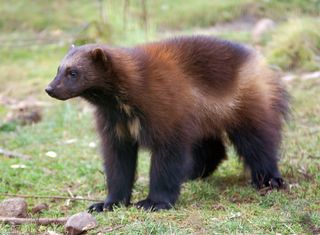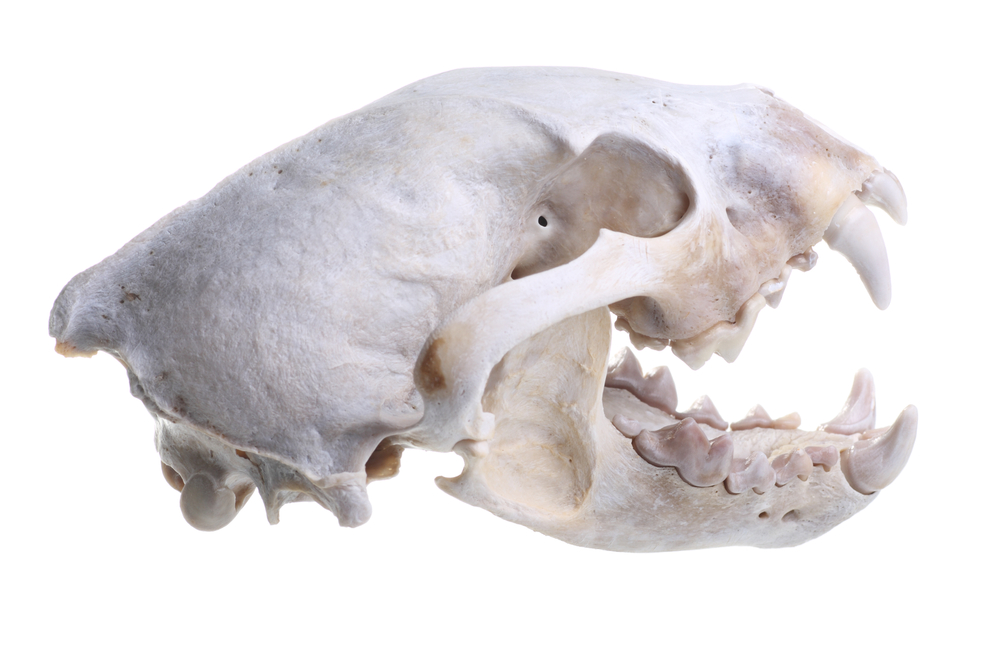Which Member of the Weasel Family Has the Scientific Name Gulo Gulo?
Facts Well-nigh Wolverines

Wolverines wait something similar a mixture of a dog, a skunk and a behave, with short legs, long hair and elongated snouts. Wolverines also have a distinctive mask of nighttime fur effectually their eyes and forehead, and a stripe of blond or ivory fur that runs from each shoulder to the base of the animal'south tail.
Though wolverines are the biggest of the weasel family unit, according to the Integrated Taxonomic Information System (ITIS), they are still very small-scale. They are usually 26 to 34 inches (66 to 86 centimeters) from caput to rump. Their tail adds another 7 to 10 inches (18 to 25 centimeters) to their length. They counterbalance 24 to 40 lbs. (11 to 18 kilograms).
Diet
Wolverines are omnivores; they swallow both meat and vegetation. Typical meals for a wolverine include large game similar caribou, moose and mountain goats; smaller animals like ground squirrels and rodents; and even birds' eggs and berries. They like meat best, though, and volition go to great lengths to go it. They tin travel xv miles (24 kilometers) in a 24-hour period in search of nutrient and will fifty-fifty eat dead animals they did non kill.
Wolverines take a groovy sense of smell; they can olfactory property prey 20 anxiety nether the snow. They will dig down into burrows and impale hibernating animals.
Wolverines are sneaky when finding food, too. They have stiff jaws and teeth, and can crush a carcass and munch right through the bone. They take been known to consume the basic and teeth of their prey.
Wolverines also seem to be enlightened of how to shop food. Research shows that wolverines use snow as refrigerators to keep their nutrient fresh. During times when nutrient is scarce, the wolverines will get back to their stockpile to and remember a repast.
Habitat & habits
Wolverines prefer colder areas because they employ the snow for dens, besides nutrient storage. They live in the Arctic and subarctic, in grasslands, Tall forests, taiga, boreal forests and tundra of Europe, Asia, and in North America in the northern latitudes.
Wolverines are solitary creatures, and need great swaths of territory to roam. Males marking their territory with their scent and only share their turf with females. Their territories can range from xl miles (65 km) to more than than 372 miles (600 km).

These hunters are nocturnal, which means they sleep during the day and chase at night.
Offspring
Wolverines are polygamous. This ways that a male person volition mate with several females. They mate from May to Baronial. After mating, females create dens in which to have their immature. These dens are ofttimes caves dug in the snow and can exist upwardly to xv feet deep.
Females give birth to ii or three young at the same time every year, which is ordinarily in the belatedly winter or early spring. About young are born between February and mid-March.
Baby wolverines are chosen kits. Kits are built-in with their optics closed and are covered in white fur. While the females handle the majority of the rearing, males volition visit from time to fourth dimension and care for the young.
Sometimes, kits will stay with their mother until they are set to have kits of their own. Wolverines are fix to reproduce at around 2 years old. Usually, though, kits head out on their ain by September, according to The Wolverine Foundation. Wolverines typically alive seven to 12 years.
Classification/taxonomy
The taxonomy of wolverines, according to the Integrated Taxonomic Information Arrangement (ITIS), is:
- Kingdom: Animalia
- Phylum: Chordata
- Class: Mammalia
- Order: Carnivora
- Family unit: Mustelidae
- Genus and species:Gulo gulo
- Subspecies:Gulo gulo albus, Gulo gulo gulo, Gulo gulo katschemakensis, Gulo gulo luscus, Gulo gulo luteusand Gulo gulo vancouverensis
Conservation condition
Wolverines are not endangered. The International Union for Conservation of Nature's Reddish List lists them as "Least Concern" for extinction, although their numbers are decreasing, specially in Europe, where it is considered "Vulnerable." Their population is estimated to be between 15,000 and 30,000 individuals. The biggest threat to wolverines is climate modify. Warmer weather could mean less snow, which wolverines are dependent on for nutrient and reproduction, equally mentioned earlier.
Other facts
When a wolverine takes a stride, its paw spreads to near twice its original size equally it presses against the ground. This makes it easier for wolverines to walk on snow. It's like built-in snowshoes.
Other members of the weasel family include skunks, sea otters, badgers and ferrets.
The wolverine's scientific name,Gulo gulo, comes from the Latin word gulo, which ways "glutton."
M56 is a wolverine that was fitted with a tracking device near Grand Teton National Park in Wyoming. During but two months, the wolverine walked more than 500 miles.
Wolverines are also chosen skunk carry, quickhatch (of Native American origin), carcajou (French for wolverine), glutton and stink-bear.
Nina Sen contributed to this article.
Other resources
- National Geographic: Wolverine
- PBS Nature: Wolverines
- National Wildlife Federation: Wolverines
- BBC Nature: Wolverine
- Canadian Geographic Kids: Wolverine
Source: https://www.livescience.com/27461-wolverines.html

0 Response to "Which Member of the Weasel Family Has the Scientific Name Gulo Gulo?"
Post a Comment